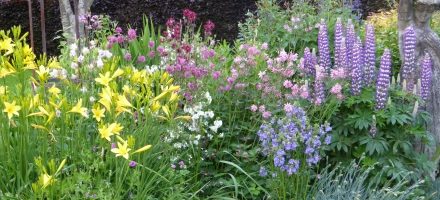Bearded Irises; Some History, Some People, Some Plants
On 28 February ODGC welcomed Alun and Jill Whitehead of Aulden Farm, Leominster, nurserymen and breeders of bearded irises,  so called because of the hairs growing along the centre of the falls or lower petals.
so called because of the hairs growing along the centre of the falls or lower petals.
These hail from warmer regions of Europe and Asia but adapt well to the British climate provided they are given a fairly free draining position in a sunny spot. Although of religious and artistic significance since at least 1550BC it was not until the C19 that breeding of different cultivars took off. Noted breeders included Lemon, William Rickatson Dykes, Arthur Bliss and Cedric Morris. In the late 1800s Sir Michael Foster asked friends to bring back irises from abroad for his breeding programme and his great, great, granddaughter, Lucy Skellon has carried on the family tradition and exhibits at Chelsea. Currently the National Collection is held by Claire Austin.
For centuries orris root has been used in homoeopathic cures and the production of perfume and gin. The leaves have been used to make paper. They have provided inspiration to many artists including Monet, Van Gogh, Georgia O’Keefe and Timothy Easton.
These sumptuous beauties come in a wide range of colours and colour combinations ranging from deep purple to white, yellow, orange, red and green and provide colour from March onwards. They fall into four types, miniature, median, intermediate and tall. Miniatures such as African Wine and Knickknack are the first to bloom and can be used in the rockery or containers. Median, between 15 and 24 inches hold themselves erect and are useful for an exposed site. Intermediates such as Evening Pond start to bloom at the end of April and the tall varieties such as Millenium Falcon and Smart Aleck carry the show into summer. Rebloomers – Fast Forward and Autumn Circus for example extend the season into Autumn.
Bearded irises are tolerant of many positions but do best in fertile, free draining, slightly alkaline soil in a sunny open position. They are propagated from sideshoots and best grown in pots and planted out in May. For the patient gardener they come readily from seed and take three years to flower. With their upright sword shaped leaves they are very effective on their own in a border and also are useful as accent plants. The two major diseases which can affect them are soft rot and leaf spot.
The club was treated to an inspiring slideshow illustrating the huge colour range of these magnificent plants and the versatile plant combinations to which they lend themselves.
Ghislaine Arundale








